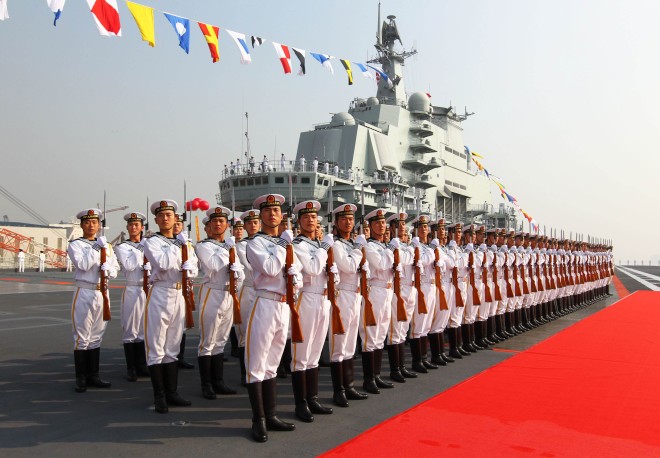Experts on China’s Navy are sounding cautionary tones after news surfaced last week that China is reportedly constructing a second aircraft carrier.
The Chinese-language report from Hong Kong-based Ta Kung Pao, known as a veteran pro-Beijing newspaper, stated that Wang Min, a Communist Party secretary of China’s northeastern province of Liaoning, has confirmed the construction of the ship, which unlike its first carrier, is homegrown.
China’s first aircraft carrier, the Liaoning, began life as the unfinished Ukrainian ship Varyag and was abandoned after the Soviet Union collapsed. Varyag was sold in 1998 for $20 million to a Hong Kong developer, ostensibly for refurbishment as a casino in Macao.
Instead of being towed there, it was towed to Dalian shipyard in northeastern China and refurbished. Commissioned in September 2012, the ship conducted flight tests with its first carrier-borne fighter jet, the J-15 Flying Shark.
According to Ta Kung Pao, Wang told delegates at the 12th Provincial People’s Congress last week that the first indigenously built aircraft carrier was under construction at the Dalian shipyard and would take six years to complete. Wang said the People’s Liberation Army Navy (PLAN) needs a total of four carriers by 2020.
“They’ll have to hurry if they are going to have four carriers by 2020, though,” said Roger Cliff, senior fellow with the Asia Security Initiative at the Atlantic Council.
“If, as Wang says, it takes six years to build one, then they would have to start three of them this year,” he said. “That’s not how the PLA Navy usually does things. Unless it is a copy of the Liaoning, I would expect them to build only one first, try it out, and see if they are satisfied with the design before building additional examples.”
Whether the PLAN is building four or 40, US analysts are saying that China needs to be taken seriously.
“It means that the PLA and the party are serious about operating carrier battle groups in the near and far seas by about 2020,” said Larry Wortzel, a senior member of the US-China Economic and Security Review Commission. “This was one of the goals for the PLAN, and it means that China can project power more effectively in the South China Sea.”
Wortzel is the author of a new book, “The Dragon Extends Its Reach.”
In November, China asserted the right to conduct more surveillance and control over the East China Sea with an air defense identification zone, and expectations among US analysts are high that a zone for the South China Sea will be declared this year.
The Hong Kong newspaper further claimed, quoting PLAN senior Capt. Li Jie, that the second carrier would be a medium-sized vessel in the 53,000-ton range, the same tonnage as the Liaoning. Li was further quoted as stating that rumors that other carriers would be built in other shipyards are untrue. He said Dalian had the most experience in building advanced warships, including submarines and the refitting of the Liaoning.
This could be evidence of regional competition at a high political level for military business in China, said Richard Fisher, a senior fellow at the International Assessment and Strategy Center. “The top Communist Party leader for Liaoning province, or the Dalian-area aircraft carrier complex, is touting his carrier program over Shanghai’s developing carrier construction complex.”
In 2013, the Dalian Shipyard and Shanghai’s Jiangnan-Changxin shipyard produced segments of aircraft carrier hulls.
“This was done to prove capability, but in Jiangnan’s case, the segment will soon grace a new corporate park for employees. I fully expect that Jiangnan will also start a carrier project very soon, meaning China will soon have two carriers under construction,” said Fisher, author of the book, “China’s Military Modernization.”
China conducted its first exercise in December in the South China Sea as a complete Chinese “aircraft carrier battle group,” said Bernard “Bud” Cole, a China naval specialist at the US National War College.
The exercise also resulted in an incident at sea between a US Navy cruiser and a PLAN amphibious warfare vessel.
“The Liaoning is more a political statement than a formidable warship — primarily because of the severe weight restrictions on the embarked J-15 aircraft because of the ‘ski jump’ configuration of the ship,” said Cole, author of the book, “The Great Wall at Sea.”
Future carriers, he said, may have to be outfitted with catapults or employ a lighter aircraft, “possibly a derivation of the J-31” stealth fighter.
Four carriers would give China a real, albeit limited, blue water capability, Cliff said, adding, “Let’s not get too excited, though.”
The Liaoning carries about 22 fixed-wing combat aircraft, compared to 72 for a US Nimitz-class carrier. “So each Chinese carrier will have only a third of the combat power, at best, of a US carrier,” Cliff said. Chinese anti-submarine warfare capabilities are weak, so protecting its carriers from US attack submarines would be problematic.
Four Chinese carriers in the medium-tonnage range would not represent a significant threat to US naval supremacy, he said. “They would, however, give China the capability to project air power against lesser countries outside of the range of China’s land-based aircraft,” said Cliff, co-author of the book, “The Chinese Air Force: Evolving Concepts, Roles, and Capabilities.”
“And for missions like counterpiracy patrols off of Somalia, having a carrier around would be nice, because it can cover a lot more area and more targets than a surface combatant,” Cliff said


